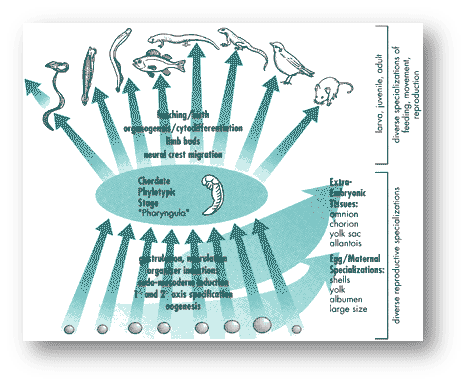 |
| Diagram showing "evo-devo" evolutionary process |
Advances in studying
genes mean that scientists in evolutionary developmental biology or
"evo-devo" can now explain more clearly than ever before how bats got
wings, the turtle got its shell and blind cave fish lost their eyes, says
University of Massachusetts Amherst evolutionary biologist Craig Albertson.
He recently won a
five-year, $625,000 Faculty Early Career Development grant from the National
Science Foundation (NSF) to study the evo-devo of jaws in cichlid fish,
tropical freshwater relatives of the tilapia. These highly adaptable cousins of
sunfish, usually medium-sized and looking a bit like perch, have a phenomenal
ability to undergo evolutionary change. They've developed 1,000 new species in Lake
Malawi, Africa, over the past million years, a far faster pace than usual for
other vertebrates in a similar period.
The NSF grant is
the foundation's most prestigious award in support of junior faculty who
exemplify the role of teacher-scholars through outstanding research, excellent
education and the integration of both.
Through evo-devo
studies, scientists now know that much biodiversity is due not only to
differences in genes, but to changes in how and when genes are expressed, says
Albertson. They also now recognize that genes interact with each other and the
environment in development to determine phenotype, or an animal's observable
traits.
"This carries
Charles Darwin's ideas forward to a new level, to previously unconsidered
sources of variation that can affect the evolution of traits. One in particular
is phenotypic plasticity, the idea that different patterns of variation will be
produced in different environments," Albertson says.
He chose to study
evo-devo in cichlid fish because "they're obviously doing something right,
from an evolutionary perspective, in a very dynamic environment, Africa's Rift
Valley." Lake Malawi water levels have fluctuated up to 300 meters in the
past 2 million years, providing everything from clear fresh water to an oxygen-poor
soup high in salt, alkali or sediment, for example, but cichlids continue to
adapt and survive.
Jaws are a good
marker of adaptation because they are linked to survival, and the jaws of Lake
Malawi cichlids can change rapidly to take advantage of new food resources. For
example, open-water feeders have long jaws to snatch free-swimming, mobile
prey, while bottom-feeders tend to have short, stout jaws for scraping algae
from rocks. It is clear that these differences in jaw type are genetically determined,
but Albertson wants to find out how much is also determined by the environment.
In studies he
started at Syracuse University before coming to UMass Amherst in 2011,
Albertson and colleagues are working to identify the set of genes responsible
for determining jaw shape in both "normal" and "extreme"
environments. They are taking a genetic mapping approach, using hybrids from a
cross between two species differing subtly in jaw length. To begin, they raised
an initial group of hybrids on an algae-based flake food, which is very easy
for the fish to eat, Albertson explains. This population will be used to map
genetic determinants of jaw shape under "normal" conditions.
Next, the
biologists split the resulting hybrid families and reared them on two different
diets, an algae-based diet spread on lava rocks, requiring fish to scrape to
feed. These fish developed shorter jaws to accomplish this. The other treatment
involved the same food, this time ground and sprinkled on the water surface.
These fish had to suck food out of the water column; they developed longer jaws
as they became more efficient at this task.
As Albertson
explains, "The idea is that these two conditions should be similar to
those in early Lake Malawi, when fish first arrived from surrounding rivers.
Presumably the ancestors of Lake Malawi cichlids all looked the same, but some
went up to suction feed while others went down to scrape, and plasticity produced
fish with different jaw lengths. By re-creating this scenario and mapping the
genes that underlie these environmentally induced shape differences, we hope to
learn about the genetic interactions that were the first step in producing the
1,000-plus species in the lake today."
One key question he
and his colleagues want to answer is whether the same set of genes are involved
in developing crushing jaws and sucking jaws under normal and extreme
environments. "We don't know if patterns of plasticity will affect
patterns of evolution. We may see a different genetic response to distinct
mechanical stimuli. But if we do recover a common set of genes under both
normal and extreme conditions, it would substantiate key theories with respect
to plasticity's role in evolutionary change."
Albertson
also plans to reach out to high school science teachers with workshops to offer
new perspectives on genetics and evolution. "Evolution has been taught
largely the same way for decades now," he says. "But today evo-devo
has produced a much more detailed understanding and appreciation for fine
points of evolution. We now know, for example, the genetic and developmental
processes responsible for how the bat got its wings and how the whale lost its
hind limbs. These are compelling examples of evolutionary change that should
resonate with students. It is a really exciting time to be an evolutionary
biologist!"
Story Source:
The above story is reprinted from materials provided by University of Massachusetts Amherst, via Newswise.
No comments:
Post a Comment